

Vol. 41 (Issue 15) Year 2020. Page 11
NAZAROVA, Galyna V. 1; LUHOVA, Viktoriia M. 2; SEMENCHENKO, Alina V. 3; IVANISOV, Oleg V. 4 & NAZAROV, Nikita K.
Received:31/10/2019 • Approved: 20/04/2020 • Published 30/04/2020
ABSTRACT: The article is devoted to the issues of implementation of party management at industrial enterprises of Ukraine. The essence of participatory management, its principles, advantages and limitations of application are considered. A model of participative control as a queuing system is proposed. Its use in industrial enterprises has made it possible to assess the degree of loading of the management body, the effectiveness of its activity, identify weaknesses and deficiencies in structure and competence. |
RESUMEN: El artículo está dedicado a los problemas de implementación de la gestión de partidos en empresas industriales de Ucrania. Se considera la esencia de la gestión participativa, sus principios, ventajas y limitaciones de aplicación. Se propone un modelo de control participativo como sistema de colas. Su uso en empresas industriales ha permitido evaluar el grado de carga del órgano de administración, la efectividad de su actividad, identificar debilidades y deficiencias en la estructura y competencia. |
Increasing the social role of a person, recognizing his or her greatest value to the organization, as well as the awareness of the personnel of their own involvement in the final indicators of the organization's activity requires further investigation of the peculiarities of the economy, based on the participation of employees in the management of the organization (participatory management). The term "participatory management" means that management is based on the participation of employees in the management of the organization. Although initially participative management has been associated solely with the introduction of new methods of work motivation, it is now seen as an effective mechanism for harnessing the human resources of an organization and developing them. Understanding the problem of participatory management and its solutions in organizations will increase the efficiency of work by increasing the level of motivation, increasing the trust and loyalty of employees, better information sharing and more effective problem solving.
It shows that the term "participatory management" is used in various fields of science: economics, politics, pedagogy, etc., and in every direction, there are many definitions of this concept. Gono (2001) considers participatory management as a process where subordinates share significant degree of decision-making power with their immediate superiors. According to Bulin (1996), participation is about employees playing greater part in the decision making process. It is a democratic philosophy that respects all members of an organization as an endless resource able to contribute knowledge and creativity to improve its ability to survive.
Potudanskaya , Shalai, Novikova (2012) state that participatory management involves the transfer of knowledge, power and autonomy to employees, so that they can carry out their work under their own responsibility and to a large extent on their own. Safonov (2016) considers participatory management as a practical manifestation of humanization of organizational relations, which involves participation in the decision-making not only of executives, but also of all other employees focused on the success of the common cause, even if this activity is not within the sphere of their direct job responsibilities.
Participative management according toScriptunova E., Mukhametshina E. (2019) means involving employees in management, employees of all levels of the organization are involved in setting the goals of the company, making decisions and analyzing and solving problems. Shvets (2015) noted that the partnership of managerial activity in different social spheres can be characterized differentially with respect to the subject and the object of management. Signs of partisanship on the part of the manager are: delegation of part of powers and resources to executors; employee involvement in planning, implementing organizational change, preparation and decision making; involving employees in the exercise of control functions; the influence of performers on the quality of the end result of the activity; openness of the manager in relations with his subordinates. On the part of the performers the signs of participation are: empowerment in decision-making and independent planning of their activities (pace, mode of operation, resources used); delegation of control and management responsibilities; participation in improving the organizational structure and choosing the areas of cooperation with other contractors; the right to use the end results of the activity. According to scientists and practitioners, participative management is one of the most promising areas of modern governance in various fields of social activity. This application allows the company to obtain a number of significant benefits, which is confirmed by numerous studies. Irawanto (2015) shows that there is a significant relationship between employee participation in decision-making and work motivation. Employee participation in discussion on recent issues (participation consultation) with employees and among workers is likely to have a significant effect on increasing their motivation. Multiple regressions analyze by Kim (2002) show that managers' use of a participative management style and employees' perceptions of participative strategic planning processes are positively associated with high levels of job satisfaction. The study suggests that participative management that incorporates effective supervisory communications can enhance employees' job satisfaction. According to Mustayeva, Tonkonog & Ananchenko (2016), the main advantages of using participatory management are that the employee's involvement in making strategically important decisions allows him or her to feel important to the organization, thereby enhancing and enhancing overall collective identity; the efficiency of managerial decisions significantly increases, the time for their implementation is reduced due to the fact that ordinary, linear employees are involved in the management process, they are more aware of the features of the production process and its real problems; productivity increases; increases staff loyalty while reducing resistance to organizational change; the team spirit in the company is strengthened. Nazarova, Stepanova (2013), Doronina, Luhova, Sasina & Nadion (2010) consider participatory management an effective method of motivation.
However, in order to take full advantage of participatory management and minimize potential disadvantages, its key principles must be adhered to. Semyanovsky (2018), Andreeva, Agapova (2011) include the following principles:
Voluntary nature of participation. That is, proposals should not be forced to work in small groups, commissions that provide the development and choice of alternatives;
Ongoing assistance and support for the small group leader or committee, providing the information necessary for discussion;
Regulation of work of employees. There should be regulations for all forms of participation (proposals, participation in cross-functional commissions, etc.);
Lack of sanctions for proposing ideas and proposals;
All employee experience should be considered, feedback is needed on any idea. Even if the proposal is rejected, you must inform the employee and explain why the decision was made;
All ideas that have found approval must be implemented. The supervisor should facilitate the implementation. If employees see that their ideas are simply stacked, the enthusiasm quickly fades away;
Any achievements of the staff should be celebrated; it is necessary for the staff to know which of their achievements were valuable and the movement in which direction is welcomed.
The mechanism of implementation of participatory management is the practice of creating cross-functional commissions in which experts from different departments discuss some topical problem of organization and each contributes to the overall result of the group. The implementation of this mechanism at industrial enterprises of Ukraine requires solving a number of issues, including the workload and efficiency of commissions. This article is devoted to the study of this issue.
Text Su For lossless systems (with unbounded expectation), quite important indicators of quality of service efficiency are: average number of requests (queries) in the queue, average number of requests in the system, average time of stay of the request (request) in the system, idle or load factor of the serving system, etc. Therefore, the main task of the analysis when using models of queuing systems is to find the functional dependencies of the selected performance indicators on the characteristics of the input flow, the parameters that characterize the serving system, the rules of queue formation and discipline of maintenance.
Given that participatory management is a combination of employees in committees (boards), for which requests (issues) should be considered and resolved, it can be represented as a queuing system (QMS) (Fig. 1). The basics of queuing theory were reviewed by Kudryavtsev (1984), Kartashevsky (2013). To define the model of the system in the form of queuing system it is necessary to: specify flow characteristics and query sources and the characteristics of the serving system. The proposed system according to the nature of the source of the requirements is open and closed (the request can come from both the external environment and from the middle, and after eliminating the reason for rejection and withdrawal the request remains in the system). The nature of the behavior of the requirements in the system with expectation without restrictions; on discipline of service of inquiries; on receipt. The number of such requests is unforeseen. Therefore, the efficiency of the whole system depends on how rationally built the work is.
Figure 1
Model of participatory management
as queuing system
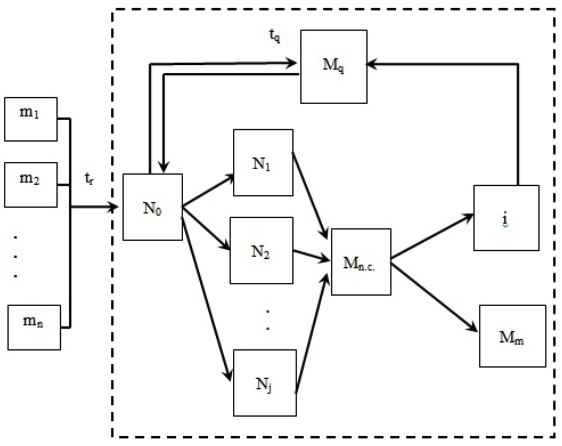
Source: author’ computations
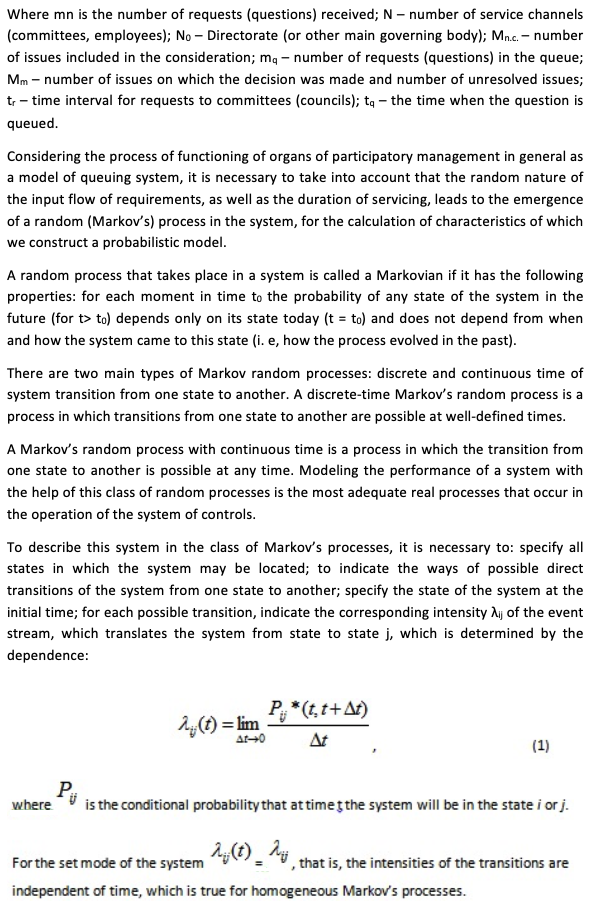
It should also be noted how the concept of status is introduced when describing the process of functioning in a class of Markov’s processes. The definition of a state depends on what properties in the behavior of the system are considered. Thus, in the case of a system reliability investigation, the dynamics of the system is a process of alternating failures and restorations of both the elements and the system as a whole, or the process of entering the system at random moments of requests and servicing them.
In the former case, the state of the system may be defined as the set of states of the elements, each of which may be either in the active state or in the failure state.
Otherwise, the system status is defined as the number of requests that are on the system. If the requests are homogeneous and the service is single-phase, then the state is determined by the value of a nonnegative scalar value; if the requests are heterogeneous and system service is multiphase, the state can be defined as a vector of the number of requests, each component of which indicates either the number of requests of this type in the system or the number of requests that are in a particular phase of the system.
Thus, for the system of participatory management the following conditions are possible:
the system is in a passive state – the meeting of the council does not take place due to the absence of issues that need consideration or the absence of a quorum for the meeting;
all service channels and the system as a whole are in active state – all committees or board members are downloaded, i. e., prepare decisions on request;
one or more service channels are in a state of failure – one or more contractors (committees or board members) do not work.
If a complete set of states of a Markov’s process is defined, then its exhaustive characteristic is the set of probabilities Pj (t) that the process at time t will be in the state zj; j = 0, 1, 2,…, n.
Suppose m requests to t are received in time, which may relate to one or more powers of the board. Consider the case when all m queries belong to one competency classification group and represent one system.
Each of the m requests to the board may at any time be removed from the system or queued under certain circumstances. The flow intensity of each request is λ. Each request that is rejected and queued is restored with a service flow intensity μ.
The operation of the PU system in this case can be represented as a model of a closed queuing system, which is described in the class of Markov’s processes of death and reproduction. This model description requires the source to contain only uniform requirements; the flow of requirements was the simplest Poisson flow; the law of service is indicative. The request for queuing is accepted as a service requirement.
Let's define the system states that we counted, considering the number of requests that were rejected and assigned to the queue: Ho – all requests were processed and a positive decision was made, H1 – one request was rejected, Nm – all m requests were rejected and queued.
If the complete set of states of the Markov’s process system is defined, then the exhaustive characteristic of the Markov’s process is the set of probabilities (t) that the process will be at time t in the state No (i = 1, .. m).
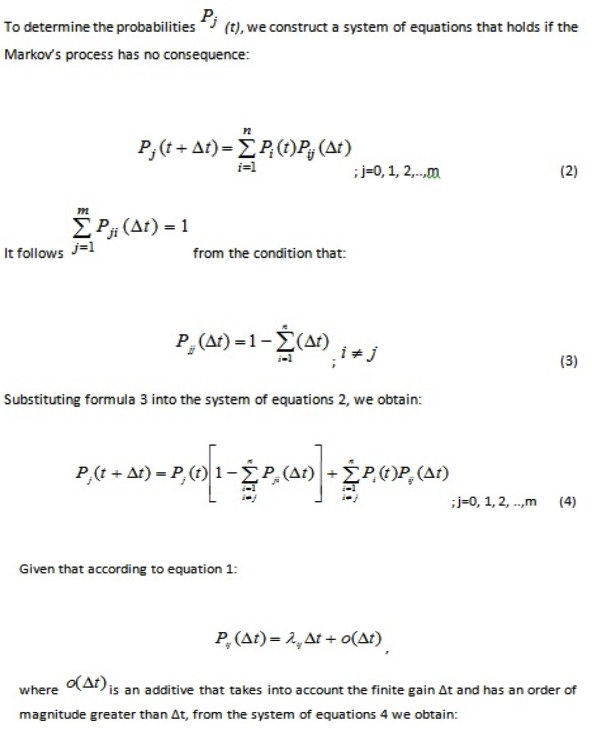
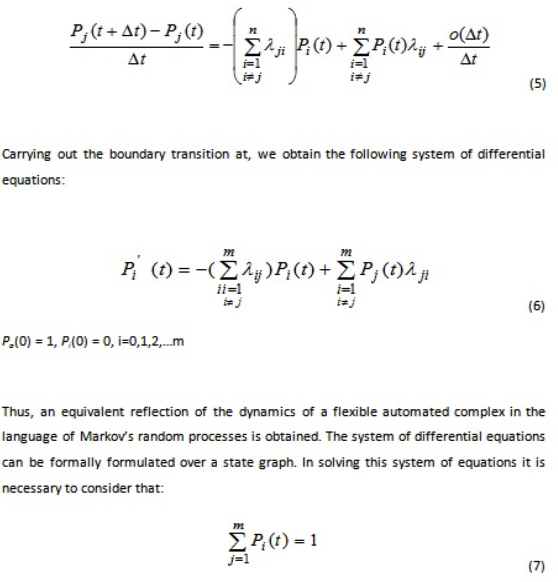
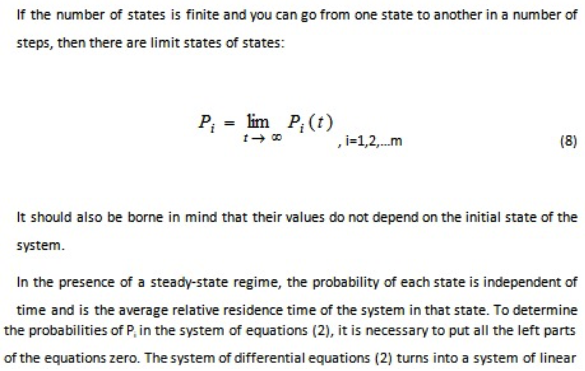
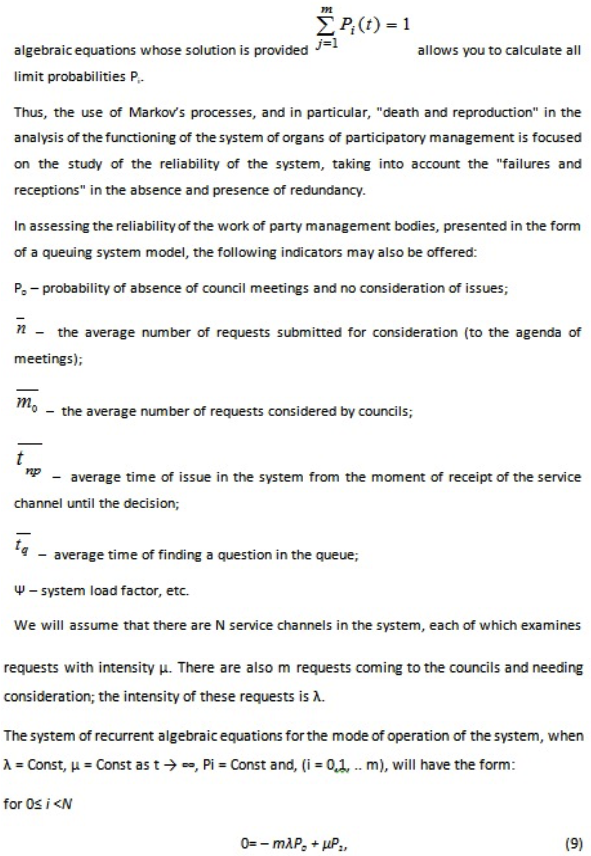
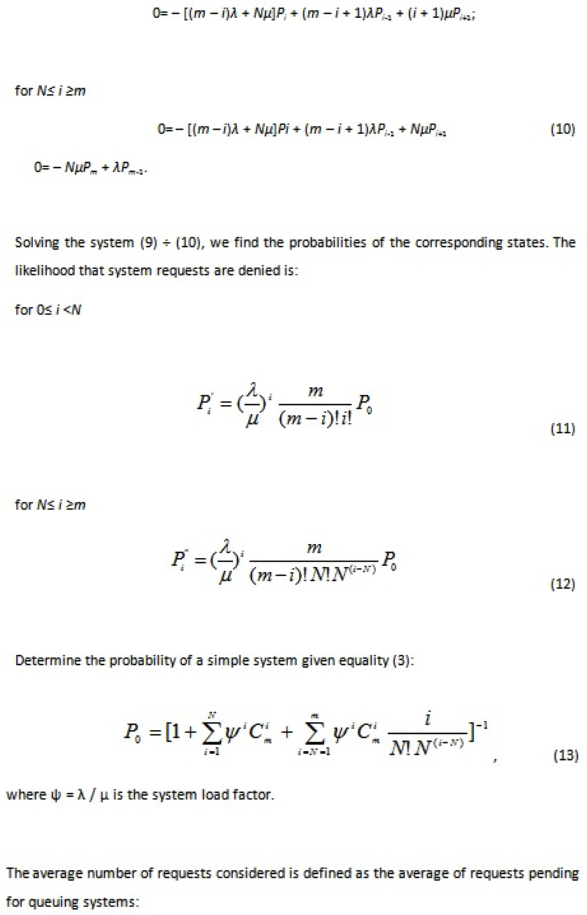
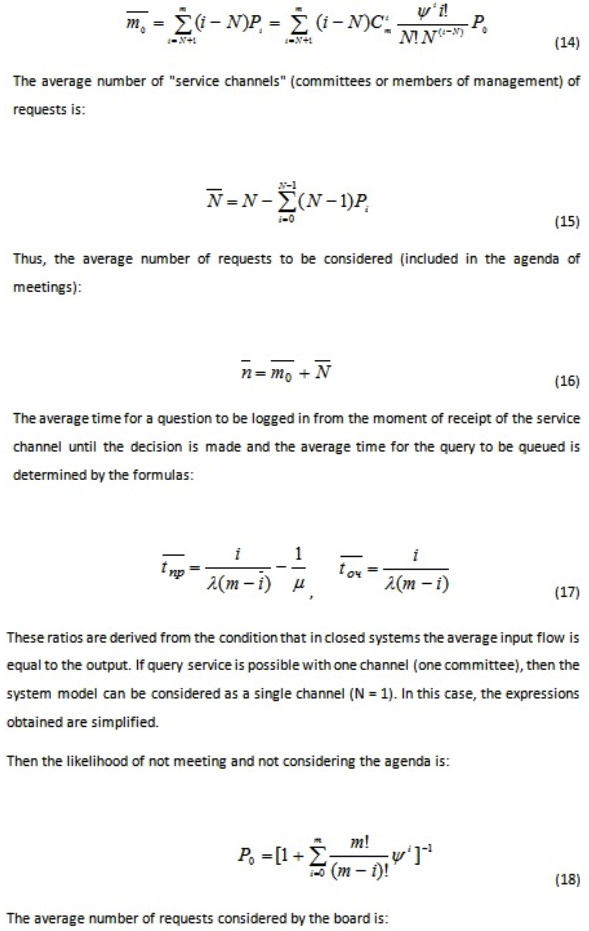
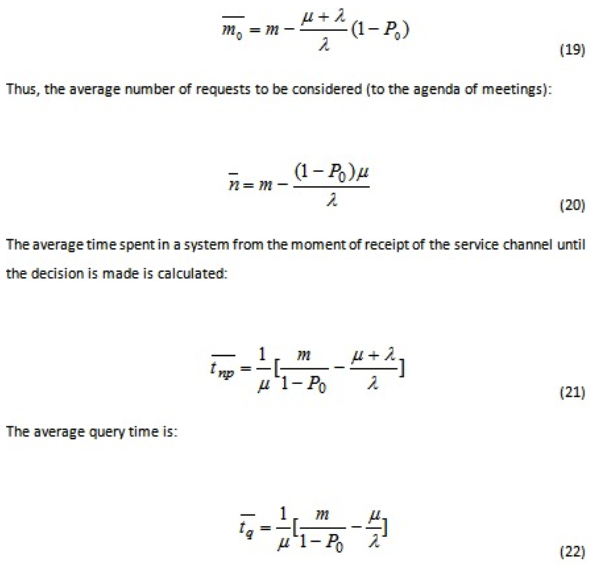
For all of these characteristics, numerical values can be found that will describe the operation of this system over a period of time in case its structure and query structure do not change, and accordingly the indicators of reliability and reproducibility will remain unchanged.
The basis for the calculation may be the statistical data obtained as a result of a survey conducted by members of management bodies of industrial joint-stock companies in Kharkiv and Kharkiv region, Ukraine. The developed methodology was applied at such enterprises as LTD KAMAZ-UTK and LTD Turbocharger Plant and is planned to be implemented at the PJSK YUZHCABLE WORKS, SE MALYSHEV PLANT, JSC TURBOATOM, and PJSC Kharkiv Tractor Plant.
These enterprises are leaders in the field of mechanical engineering in Kharkiv region and have the necessary resources to improve the management system.
At the same time, it should be noted that the definition and calculation of indicators that characterize the workload and performance of councils, presented in the form of queuing model, which is described in the class of death and reproduction Markov’s processes requires a large amount of rather complicated calculations. In this regard, it is advisable to use various applications and modeling systems such as GPSS WORLD, Mathcad, Matlab and Excel.
Based on the above, we calculate the considered indicators for two joint stock companies: KAMAZ-UTK LTD and Turbocharger Plant LTD, using the capabilities of Microsoft Office software such as Excel, which allows you to solve many economic and mathematical problems.
It should be noted that the supervisory boards of LTD KAMAZ-UTK and LTD Turbocharger Plant do not have committees, which will make the system considered as one-channel. The initial data and indicators that characterize the workload and reliability of the system are presented in the form of a table (table 1).
As can be seen from the table 1, the supervisory board of KAMAZ-UTK LTD received 10 questions for a certain period, while the Turbocharger Plant LTD for the same time – 15. It should also be noted that both enterprises have issues that are pending (their value is 3). The intensity of receipt of questions to the councils of KAMAZ-UTK and LTD "Turbocharger Plant" is 0.35 and 0.6 respectively, while the intensity of consideration of issues is 0.5 and 0.7. This situation causes the load of the supervisory board of LTD "Turbocharger Plant" to be higher than LTD "KAMAZ-UTK" by 0.16 and is equal to 0.86.
Using formula 3.18, the probability of not holding a supervisory board meeting or considering an agenda item was calculated. Due to the small number of incoming issues and incomplete loading of the boards of joint-stock companies, the magnitude of such probability is insignificant (in LTD KAMAZ-UTK and LTD Turbocharger Plant it is less than 1%).
The average number of issues considered by the Supervisory Boards is less than the number of issues submitted to them and is equal to 8 in the KAMAZ-UTK LTD and 13 in the Turbocharger Plant LTD. This situation is due to the fact that the boards of these companies are represented as single-channel queuing systems, that is, decisions are prepared and made directly at a meeting other than multichannel systems, where preliminary preparation of decisions by committees or executors takes place, which reduces the time for consideration of the issue.
Table 1
Calculation of indicators that characterize the activities of
the Supervisory Board in terms of workload and reliability
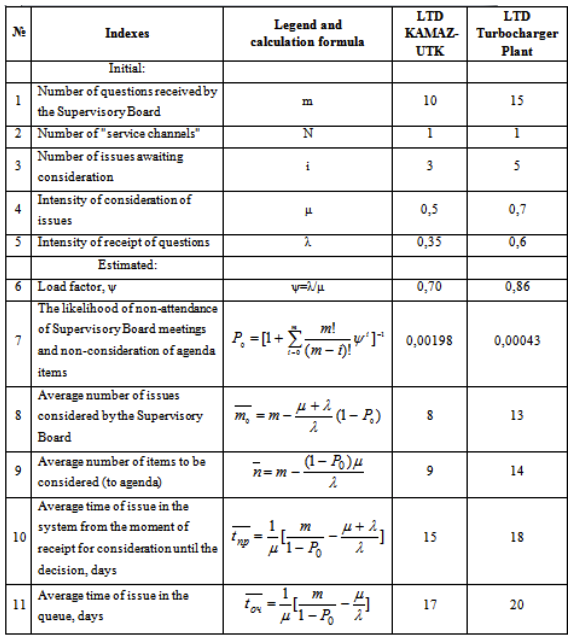
Source: author’ computations
The average time of processing and adjudication on the issue is shorter in LTD KAMAZ-UTK and is 15 days, whereas in LTD "Turbocharger Plant" this period is 18. Similarly, the average time of query waiting is in LTD "KAMAZ-UTK" the issue is in the "passive" state by 3 days less than the LTD "Turbocharger Plant". Thus, the obtained values make it possible to assess the degree of loading of the management body, the effectiveness of its activity, identify weaknesses and weaknesses in structure and competence. That is, to identify whether there is a need for a joint stock company to review the list of functions and responsibilities pertaining to the supervisory board, or to create (or vice versa) certain committees and positions of the board to improve its performance.
In this way, participative management is one of the modern effective methods of management that involves democratization, participation of employees in production management, utilization of human resources of organization and development of the enterprise. The importance of party management for Ukrainian enterprises also requires exploration of possible implementation problems.
The proposed model of participatory management as a queuing system allowed to estimate the degree of loading of the management body, the efficiency of its activity and demonstrated the viability of the system of participatory management in some industrial enterprises. The main limitation of this study is related to the number of objects studied. Further researches of the authors will be directed on elimination of this problem, research of peculiarities of work of the system of participative management at the separate enterprises and estimation of economic and social effect from implementation of participative management.
Bulin, J.G. (1996) Supervision skills for managing work and leading people. USA: Houghton Mifflin Company.
Doronina, M. S., Lugova, V. M., Sasina, L. O., & Nadion, G. M. (2010). Mechanism of motivation for management personnel. Kharkiv: AdvAtm.
Gono, Ch. (2001). The impact of participatory management on productivity, quality, and employees' morale. The Graduate College University of Wisconsin-Stout Menomonie, Wisconsin, 7.
Irawanto, D. W. (2015). Employee participation in decision-making: Evidence from a state-owned enterprise in Indonesia Management, 20, 159-172.
Kartashevsky, V.G. (2013). Fundamentals of queuing theory. Moscow: Hotline – Telecom.
Kim, S. (2002). Participative management and job satisfaction: Lessons for management leadership. Public Administration Review, 62 (2), 231-241.
Kudryavtsev, E. (1984). Operations research in tasks, algorithms and programs. Moscow: Radio and communication.
Mustaeva, N.G., Tonkonog, V.V., & Ananchenkova, P.I. (2016). Management development of innovative educational organizations based on participatory management Labor and social relations, 5, 101-115.
Nazarova, G.V., & Stepanova, E. R. (2013). Stimulation of labor activity as constituent element of decent work concept. Business Inform. 6, 23.
Potudanskaya, V., Shalai, V. & Novikova, T. (2012). Partisipative management as a direction for improving the quality of working life in industrial enterprises. Omsk Scientific Bulletin, 4, 61–63.
Safonov, K.B. (2016). Humanization of managerial relations: foreign and domestic experience. Society: sociology, psychology, pedagogy, 1, 33-35.
Scriptunova E., Mukhametshina E. (2019). Participatory structures. http://www.axima-consult.ru/
Semyanovsky, V.M. (2018). Participative management as a model of territorial community management. Statistics Of Ukraine, 1, 47- 51.
Shvets, D.E. (2015). A Partisipatory Model of Management in the Higher Education System. ZDIA Humanitarian Bulletin, 63, 249-256.
Editor's Note: All images of texts with mathematical formulas were supplied by the authors. Editorial Espacios copied them as they were in the approved original.
1. Department of Economics and Social Sciences. Simon Kuznets Kharkiv National University of Economics. Professor, Doctor of Economic Sciences. Kharkiv, Ukraine. Contact e-mail: gnazarova@i.ua
2. Department of Economics and Social Sciences. Simon Kuznets Kharkiv National University of Economics. Assistant Professor, PhD in Economics. Kharkiv, Ukraine. Contact e-mail: v.lugova@i.ua
3. Department of Economics and Social Sciences. Simon Kuznets Kharkiv National University of Economics. Assistant Professor, PhD in Economics. Kharkiv, Ukraine. Contact e-mail: alya_semenchenko@ukr.net
4. Department of Economics and Social Sciences. Simon Kuznets Kharkiv National University of Economics. Assistant Professor, PhD in Economics. Kharkiv, Ukraine. Contact e-mail: ivanisovoleg@ukr.net
[Index]
revistaespacios.com

This work is under a Creative Commons Attribution-
NonCommercial 4.0 International License